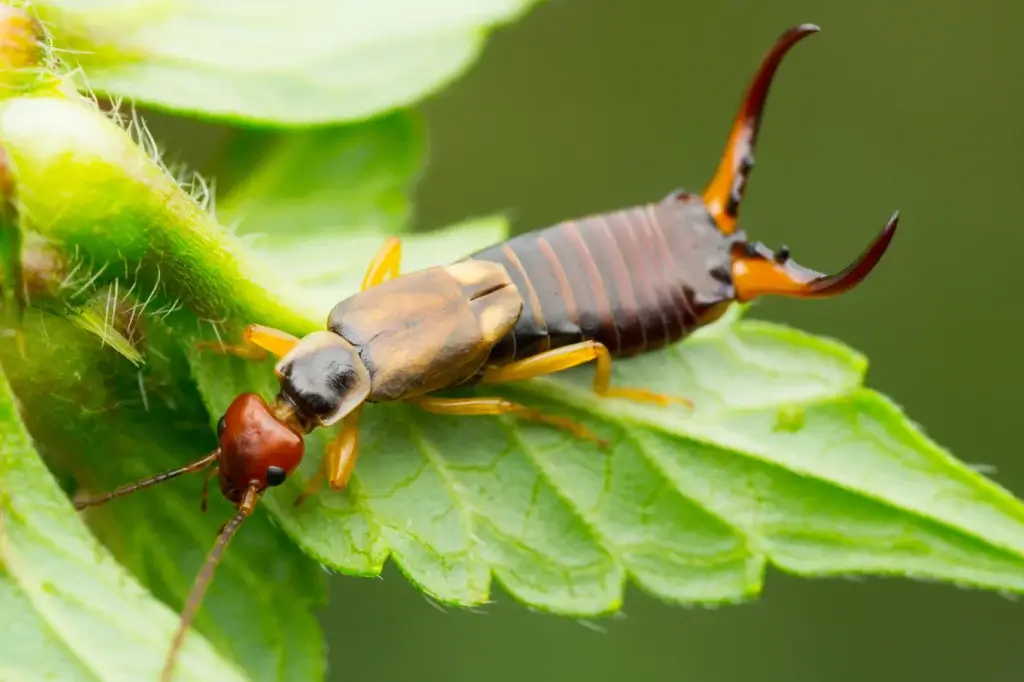
What Are Earwigs?
Earwigs are insects commonly found throughout homes in North Carolina. But, what are earwigs? Are they dangerous? Let's shed some light on these creepy critters.

Table of Contents
What Are Earwigs?
Earwigs are small, elongated insects, made even longer by distinctive pincers on the end of their bodies. They usually measure between 5 to 25 millimeters and have a slender, flattened body. This leaves many people wondering, "What are earwigs," or more importantly, "Do earwigs bite?"
Earwigs are equipped with pincers, or cerci, at the end of their abdomen, which might give the impression that they can bite. However, earwigs rarely bite humans, and when they do, it's typically a mild pinch that doesn't cause any harm. These pincers are primarily used for defense and mating purposes among earwigs themselves.
Earwigs are not venomous or poisonous, and their bite, while it may be surprising, is not dangerous.
While they might look intimidating, these insects are generally considered harmless to humans and are more focused on scavenging for decaying organic matter or small insects in their environment.
What Attracts Earwigs?
In answering the question, "What are earwigs," we need to also address what attracts them. Earwigs like dark, damp crevices and corners. They are most commonly found in mulch, leaf litter, and garden debris, as well as beneath rocks, plant pots, or flowerbeds.
Sometimes earwigs make their way indoors to areas that provide darkness, moisture, and shelter. They're often found in basements, bathrooms, kitchens, and other damp or dark spaces. Cracks and crevices in walls, around windows, and in door frames can serve as entry points for these insects. Earwigs are attracted to moisture, so areas with water leaks or high humidity levels can be particularly appealing to them.
Keeping indoor and outdoor spaces well-maintained while addressing any moisture issues can help minimize encounters with earwigs.
Earwig Breeding Habits
Understanding the reproductive life cycle of earwigs sheds light on their fascinating behaviors, and can help manage their populations in and around your home - and can help you understand, "What are earwigs?"
Mating Behavior
Earwigs engage in elaborate mating rituals during the warmer months. Male earwigs attract females through pheromones, engaging in courtship displays that involve intricate antennal and body movements. Once a mate is chosen, the reproductive process begins.
Egg-Laying and Nesting
Female earwigs are meticulous when it comes to finding the perfect place to lay their eggs. They often choose sheltered locations, such as crevices in the soil or beneath organic debris. The eggs are carefully guarded by the female, who protects them from potential predators until they’re ready to hatch.
Maternal Care
A mother earwig is diligent about caring for her eggs, and that dedication continues in the nymph stage. She guards the eggs and nymphs against threats, regulating the environment and staying on guard.
Nymphal Development
Upon hatching, earwig nymphs look like miniature versions of adults—without the wings. The nymphal stage involves a series of molts as the earwig grows and develops.
Factors Influencing Reproduction
Several factors influence the reproductive success of earwigs. Temperature, humidity, and the availability of suitable nesting sites and food play crucial roles when it comes to their reproductive success.
Life Cycle of Earwigs
We’ve covered the egg stage of these fascinating bugs, but you might still be wondering, "What are earwigs?" And what about the rest of their life cycle?
Gradual Metamorphosis
Unlike insects with complete metamorphosis, earwigs undergo something called gradual metamorphosis. The transition from nymph to adult is characterized by subtle changes in body structure and the development of wings. Earwig nymphs molt multiple times before reaching maturity.
Adult Stage
The fully matured earwig emerges, equipped with wings and pincers. Adult earwigs are primarily nocturnal, seeking shelter during the day and actively foraging for food at night. The adult stage is crucial for reproduction, continuing the lifecycle by engaging in mating rituals and laying eggs.
Habitat of Earwigs
No matter how harmless they actually are, it’s always disconcerting to find an earwig. While they can be found in homes and other buildings, they do tend to gravitate towards other areas first.
Gardens and Landscapes
One of the most familiar habitats for earwigs is gardens and outdoor landscapes. Earwigs thrive in environments rich in vegetation, such as flower beds, shrubbery, and mulched areas. They are often found among plants and organic debris, where they feed on decaying matter and prey on small insects.
Fields and Meadows
Earwigs are not limited to cultivated gardens; they are also found in natural ecosystems, including fields and meadows. In these habitats, earwigs find refuge in tall grasses, fallen leaves, and other plant materials. The abundance of vegetation provides plenty of hiding places and potential food sources for these adaptable insects.
Woodland Areas
Woodland habitats, like forests and wooded areas, are also home to earwigs. They seek shelter under logs, bark, and in the leaf litter on the forest floor. The damp and shady environment of woodlands is exactly what earwig dreams are made of.
Urban Environments
Earwigs are not exclusively found outdoors, as you probably know; they have adapted to urban environments as well. Found in and around homes, earwigs may take refuge in cracks, crevices, and other sheltered areas. They may seek shelter in attics, basements, and crawl spaces, especially during adverse weather conditions.
Diet of Earwigs
If you're still wondering, "What are earwigs," you might want to know what threats they pose to your property - and to you. So, what do earwigs eat? Contrary to some myths, earwax isn’t anywhere on the list.
Decaying Organic Matter
One of the primary components of an earwig's diet is decaying organic matter. These resourceful insects play a valuable role in ecosystems by consuming dead plant material, fallen leaves, and other decomposing organic debris. Their scavenging behavior helps the decomposition process along, contributing to nutrient recycling in the environment.
Plant Material
While earwigs are not typically considered major plant pests, they do feed on various plant materials. They may nibble on soft leaves, flowers, and the petals of certain plants. In gardens and landscapes, earwigs may be found among vegetation, where they opportunistically snack on plant matter.
Insects and Invertebrates
Earwigs are omnivorous and are known to prey on small insects and invertebrates. They exhibit predatory behavior, feeding on aphids, mites, insect eggs, and other small arthropods. This makes them helpful insects in gardens, where they can control certain pest populations.
Fungi and Mold
Earwigs also show a penchant for fungi and mold. They may feed on the mycelium of fungi and consume mold growing on decaying organic matter. This adaptability allows earwigs to utilize a diverse range of food sources in their surroundings.
Pollen and Nectar
Some species of earwigs have been observed feeding on pollen and nectar. While not all earwigs exhibit this behavior, those that do may visit flowers to feed on these sugary substances.
How to Get Rid of Earwigs
Of course, in answering, "What are earwigs," we need to address how to prevent them from making your home, theirs. If you find yourself dealing with an earwig infestation, fear not—effective elimination strategies can help restore balance to your environment.
1. Keep it Clean
The first step in managing earwigs is to eliminate potential habitats and food sources. Regularly clean up debris, decaying organic matter, and leaf litter in and around your home. By reducing these, you make your surroundings less appealing to earwigs.
2. Remove Excess Moisture
Earwigs thrive in damp conditions, so addressing moisture issues is crucial. Fix leaky faucets, repair drainage problems, and ensure proper ventilation in basements and crawl spaces.
3. Seal Entry Points
Prevent earwigs from entering your home by sealing cracks, gaps, and entry points. Use caulk to seal gaps around windows, doors, and utility entry points.
4. Natural Predators
Encourage natural predators like birds, toads, and predatory insects in your garden. These natural enemies feed on earwigs and contribute to pest control. Creating a balanced ecosystem can help keep earwig populations in check.
5. Diatomaceous Earth
Diatomaceous earth, a natural and non-toxic powder, can be sprinkled outdoors in areas where earwigs are active. This substance dehydrates and damages the exoskeleton of insects, making it an effective barrier.
Note that this is likely not a long term solution, as it will need reapplication after rain.
6. Traps and Baits
Place rolled-up newspapers or cardboard tubes in your garden, as earwigs often seek shelter in these dark, damp spaces. Check these traps regularly and dispose of any earwigs caught inside. Commercially available earwig traps and baits can also be strategically placed to attract and capture these pests, though those are less cost-effective than their DIY counterparts.
7. Essential Oil Repellents
Certain essential oils, such as neem oil, citrus oil, and peppermint oil, are known to repel earwigs. Create a natural repellent by diluting these oils with water and spraying it in areas where earwigs are prevalent.
Again, this is not a long term or the most effective solution.
8. Professional Pest Control
Consult with pest control professionals to assess the extent of the earwig infestation. Professional services can provide targeted treatments and ongoing monitoring to ensure effective control.
FAQ: What Are Earwigs?
Are Earwigs Dangerous?
When answering, "What are earwigs," this is one of the most common questions we see. This question persists even past playground rumors and old wives tales.
The truth, though, is that earwigs are not harmful to humans.Their pincers are used for defense against other earwigs, and are not strong enough to hurt a person. Plus, they are not known to transmit diseases to humans and are not aggressive.
And that myth about the ears? It’s actually just that: A myth. While earwigs do like dark places, they don’t seek out ear canals to get comfy in—and the chances of that happening are very slim.
How Did Earwigs Get Their Name?
The name "earwig" actually has its roots in the same myth that has been circulating for centuries. The term is thought to have originated from the Old English word "ēare-wicga," where "ēare" means ear, and "wicga" means insect or beetle. Even then, the earwigs pincers made people believe they were likely to burrow into one's ears.
While this belief has no factual basis, it did give rise to the name "earwig" and the associated misconception that these insects are somehow attracted to human ears.
Final Word: What Are Earwigs & How to Get Rid of Them?
Though they aren’t our biggest problem when it comes to pest control in North Carolina, earwigs can still be intrusive - and downright creepy if you seem them indoors. We hope to have answered the question, "What are earwigs?" So if you find yourself up against an infestation, you'll know exactly how to get rid of them - or who to call.
A-1 Pest Control has affordable pest control plans for every place and every pest. Give us a call today at 828-481-9140 to schedule a free pest inspection, or choose a pest control plan that works for you to get started now!
